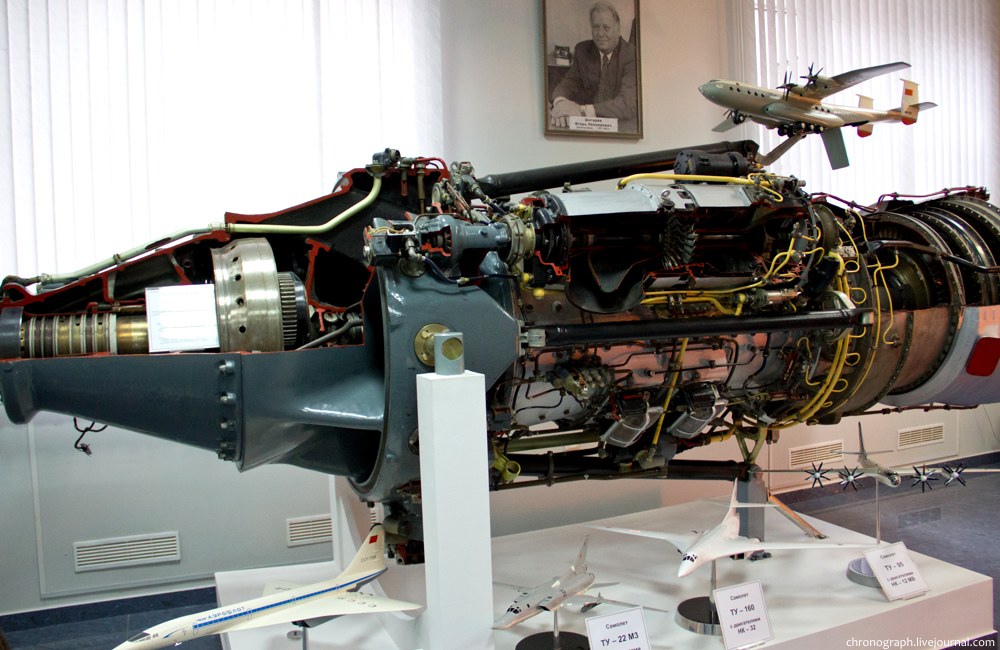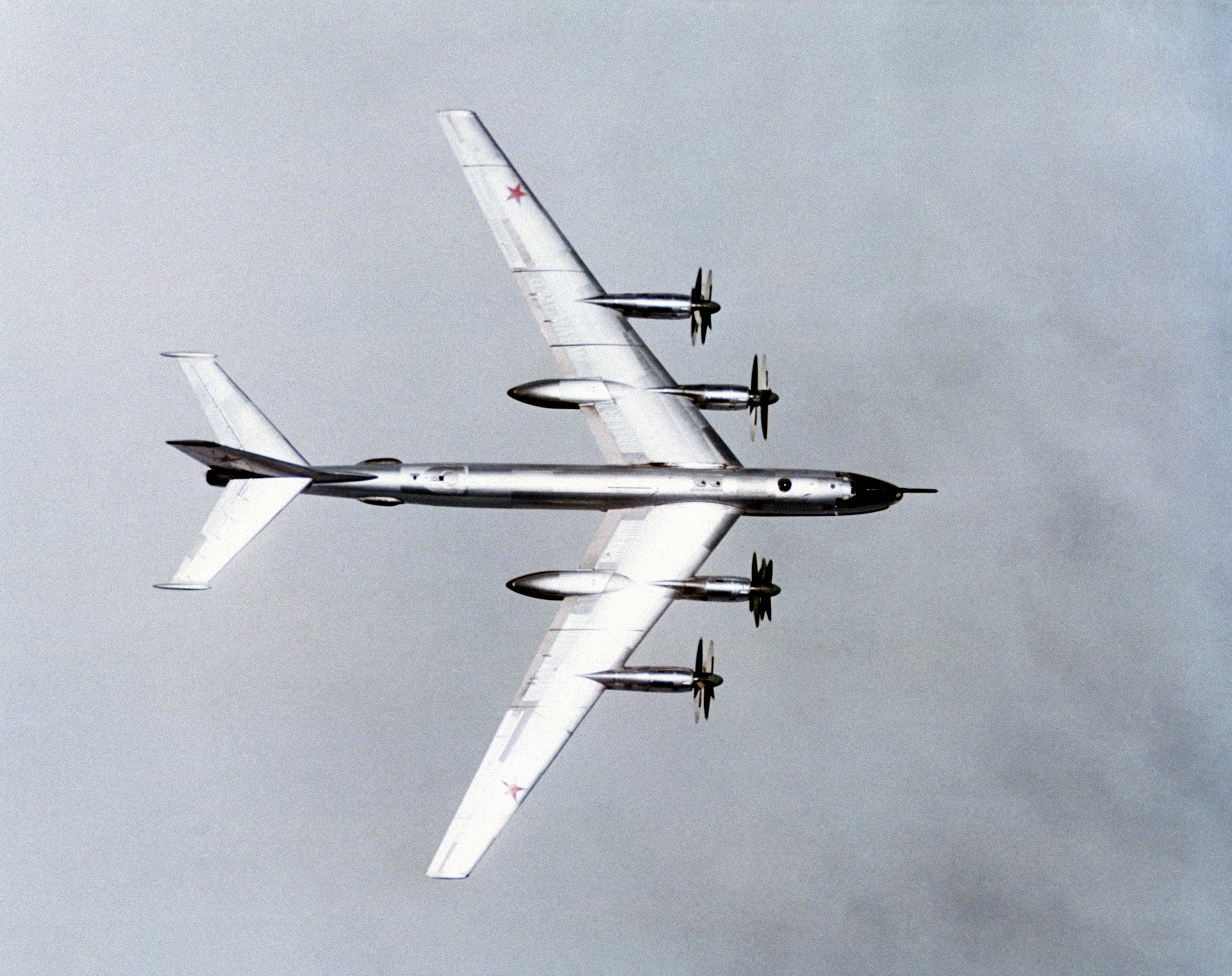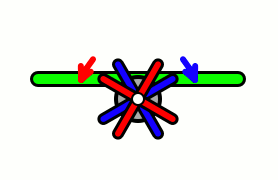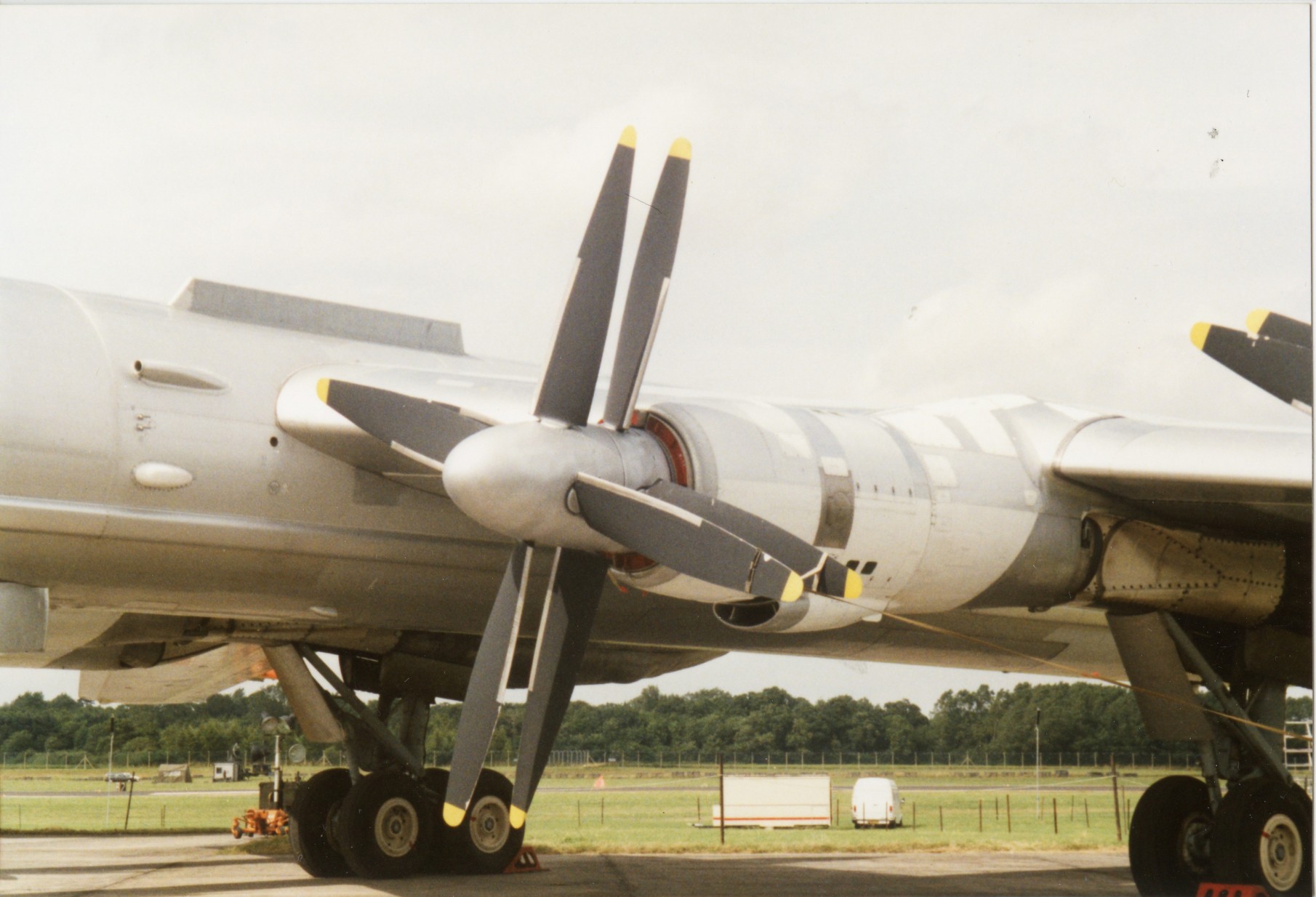|
NK-12
The Kuznetsov NK-12 is a Soviet turboprop engine of the 1950s, designed by the Kuznetsov design bureau. The NK-12 drives two large four-bladed contra-rotating propellers, diameter (NK-12MA), and diameter (NK-12MV). It is the most powerful turboprop engine to enter service. Design and development The design that eventually became the NK-12 turboprop was developed after World War II by a team of Soviet scientists and deported German engineers under Ferdinand Brandner, who had worked for Junkers previously; the design bureau was headed by chief engineer Nikolai D. Kuznetsov. Thus, the NK-12 design evolved from late-war German turboprop studies. This started with the postwar development of the wartime Jumo 022 turboprop design that was designed to develop , weighing . The effort continued with a , weighing , completed by 1947. Evolution to the TV-12 engine required extensive use of new Soviet-developed alloys and was completed in 1951. The NK-12 is the most powerful turboprop ... [...More Info...] [...Related Items...] OR: [Wikipedia] [Google] [Baidu] |
Tupolev Tu-95
The Tupolev Tu-95 (russian: Туполев Ту-95; NATO reporting name: "Bear") is a large, four-engine turboprop-powered strategic bomber and missile platform. First flown in 1952, the Tu-95 entered service with the Long-Range Aviation of the Soviet Air Forces in 1956 and was first used in combat in 2015. It is expected to serve the Russian Aerospace Forces until at least 2040. A development of the bomber for maritime patrol is designated the Tu-142, while a passenger airliner derivative was called the Tu-114. The aircraft has four Kuznetsov NK-12 engines with contra-rotating propellers. It is the only propeller-powered strategic bomber still in operational use today. The Tu-95 is one of the loudest military aircraft, particularly because the tips of the propeller blades move faster than the speed of sound. Its distinctive swept-back wings are set at an angle of 35°. The Tu-95 is the only propeller-driven aircraft with swept wings that has been built in large numbers. De ... [...More Info...] [...Related Items...] OR: [Wikipedia] [Google] [Baidu] |
Contra-rotating Propellers
Aircraft equipped with contra-rotating propellers, also referred to as CRP, coaxial contra-rotating propellers, or high-speed propellers, apply the maximum power of usually a single piston or turboprop engine to drive a pair of coaxial propellers in contra-rotation. Two propellers are arranged one behind the other, and power is transferred from the engine via a planetary gear or spur gear transmission. Contra-rotating propellers are also known as counter-rotating propellers, although counter-rotating propellers is much more widely used when referring to airscrews on separate non-coaxial shafts turning in opposite directions. Operation When airspeed is low, the mass of the air flowing through the propeller disk (thrust) causes a significant amount of tangential or rotational air flow to be created by the spinning blades. The energy of this tangential air flow is wasted in a single-propeller design, and causes handling problems at low speed as the air strikes the vertical st ... [...More Info...] [...Related Items...] OR: [Wikipedia] [Google] [Baidu] |
Ferdinand Brandner
Ferdinand Brandner (17 November 1903 – 20 December 1986) was an Austrian aerospace designer and an SS '' Standartenführer'' in Nazi Germany. While interned in the Soviet Union under Operation Osoaviakhim following World War II, he played a major role in designing the Kuznetsov NK-12, the most powerful turboprop engine ever built. Life Brandner was born 17 November 1903 to Sudeten German parents in Vienna, his father being a low-ranking government official. He served in the ''Freikorps Oberland'' in 1921, and went on to study in Vienna, earning a degree in engineering in 1925. He began designing diesel engines for locomotives, working at the Humboldt-Deutz-Motoren AG in the Rhineland. [...More Info...] [...Related Items...] OR: [Wikipedia] [Google] [Baidu] |
Kuznetsov Design Bureau
The Kuznetsov Design Bureau (russian: СНТК им. Н. Д. Кузнецова, also known as OKB-276) was a Russian design bureau for aircraft engines, administrated in Soviet times by Nikolai Dmitriyevich Kuznetsov. It was also known as (G)NPO Trud (or NPO Kuznetsov) and Kuybyshev Engine Design Bureau (KKBM). NPO Trud was replaced in 1994 by a Joint Stock Company (JSC), Kuznetsov R & E C. By the early 2000s the lack of funding caused by the poor economic situation in Russia had brought Kuznetsov on the verge of bankruptcy. In 2009 the Russian government decided to consolidate a number of engine-making companies in the Samara region under a new legal entity. This was named JSC Kuznetsov, after the design bureau. Products The Kuznetzov Bureau first became notable for producing the monstrous Kuznetsov NK-12 turboprop engine that powered the Tupolev Tu-95 bomber beginning in 1952 as a development of the Junkers 0022 engine. The new engine eventually generated about 15,000 horse ... [...More Info...] [...Related Items...] OR: [Wikipedia] [Google] [Baidu] |
Tupolev Tu-142
The Tupolev Tu-142 (russian: Туполев Ту-142; NATO reporting name: Bear F/J) is a Soviet/Russian maritime reconnaissance and anti-submarine warfare (ASW) aircraft derived from the Tu-95 turboprop strategic bomber. A specialised communications variant designated ''Tu-142MR'' was tasked with long-range communications duties with Soviet ballistic missile submarines. The Tu-142 was designed by the Tupolev design bureau, and manufactured by the Kuibyshev Aviation and Taganrog Machinery Plants from 1968 to 1994. Formerly operated by the Soviet Navy and Ukrainian Air Force, the Tu-142 currently serves with the Russian Navy. Developed in response to the American Polaris programme, the Tu-142 grew out of the need for a viable Soviet ASW platform. It succeeded the failed Tu-95PLO project, Tupolev's first attempt at modifying the Tu-95 for maritime use. The Tu-142 differed from the Tu-95 in having a stretched fuselage to accommodate specialised equipment for its ASW and survei ... [...More Info...] [...Related Items...] OR: [Wikipedia] [Google] [Baidu] |
Turboprop
A turboprop is a turbine engine that drives an aircraft propeller. A turboprop consists of an intake, reduction gearbox, compressor, combustor, turbine, and a propelling nozzle. Air enters the intake and is compressed by the compressor. Fuel is then added to the compressed air in the combustor, where the fuel-air mixture then combusts. The hot combustion gases expand through the turbine stages, generating power at the point of exhaust. Some of the power generated by the turbine is used to drive the compressor and electric generator. The gases are then exhausted from the turbine. In contrast to a turbojet or turbofan, the engine's exhaust gases do not provide enough energy to create significant thrust, since almost all of the engine's power is used to drive the propeller. Technological aspects Exhaust thrust in a turboprop is sacrificed in favor of shaft power, which is obtained by extracting additional power (beyond that necessary to drive the compressor) from turbine ex ... [...More Info...] [...Related Items...] OR: [Wikipedia] [Google] [Baidu] |
Turboprop
A turboprop is a turbine engine that drives an aircraft propeller. A turboprop consists of an intake, reduction gearbox, compressor, combustor, turbine, and a propelling nozzle. Air enters the intake and is compressed by the compressor. Fuel is then added to the compressed air in the combustor, where the fuel-air mixture then combusts. The hot combustion gases expand through the turbine stages, generating power at the point of exhaust. Some of the power generated by the turbine is used to drive the compressor and electric generator. The gases are then exhausted from the turbine. In contrast to a turbojet or turbofan, the engine's exhaust gases do not provide enough energy to create significant thrust, since almost all of the engine's power is used to drive the propeller. Technological aspects Exhaust thrust in a turboprop is sacrificed in favor of shaft power, which is obtained by extracting additional power (beyond that necessary to drive the compressor) from turbine ex ... [...More Info...] [...Related Items...] OR: [Wikipedia] [Google] [Baidu] |
Tupolev Tu-114
The Tupolev Tu-114 Rossiya ( ru , link=no, Tyполев Тy-114 Poccия; NATO reporting name Cleat) was a turboprop-powered long-range airliner designed by the Tupolev design bureau and built in the Soviet Union from May 1955. The aircraft was the largest and fastest passenger plane at that time and also had the longest range, at 10,900 km (6,800 mi). It has held the official title of fastest propeller-driven aircraft since 1960."FAI official database" '' Fédération Aéronautique Internationale''. Retrieved: 5 September 2007. Due to its swept wing and powerplant design, the Tu-114 was able to travel at speeds t ... [...More Info...] [...Related Items...] OR: [Wikipedia] [Google] [Baidu] |
A-90 Orlyonok
The A-90 ''Orlyonok'' (Russian: Орлёнок, English: "Eaglet") is a Soviet ''ekranoplan'' that was designed by Rostislav Evgenievich Alexeyev of the Central Hydrofoil Design Bureau. The A-90 uses ground effect to fly a few meters above the surface. The Russians classify it as Ekranoplan Class B – it can achieve an altitude of , placing it between Class A – which is limited to ground effect, and Class C, which exploits the ground effect only during take-offs and landings and otherwise functions as a typical airplane. History The Soviet Navy command of the 1960s was very interested in a fast military transport capable of carrying a large payload. The Central Hydrofoil Design Bureau was one of the organizations working on this top-secret project, about which little was known until the fall of the Soviet Union. Chief Designer R. E. Alexeyev designed several prototypes in the 1960s. At the start of the 1970s, Alexeyev designed a medium-sized ekranoplan to be used as ... [...More Info...] [...Related Items...] OR: [Wikipedia] [Google] [Baidu] |
Europrop TP400
The Europrop International TP400-D6 is an 11,000 shp (8,200 kW) powerplant, developed and produced by Europrop International for the Airbus A400M Atlas military transport aircraft. The TP400 is the most powerful turboprop in service using a single propeller; only the Kuznetsov NK-12 using contra-rotating propellers is larger. Development The TP400 was originally selected by Airbus Military to power the A400M in December 2000. However, Airbus reopened the engine competition in February 2002, because the engine core, which is based on the Snecma M88 turbofan fighter engine, was too heavy and used too much fuel. By May 2002, Pratt & Whitney Canada (P&WC) announced a proposal involving a turboprop with a core based on its PW800 turbofan, a regional jet engine under development that had a geared fan at the time; the concept would later be called the PW180. In 2003, around the 30 April decision deadline, Airbus Chief Executive Noel Forgeard told reporters that the P&WC ... [...More Info...] [...Related Items...] OR: [Wikipedia] [Google] [Baidu] |
Tupolev Tu-126
The Tupolev Tu-126 (NATO reporting name: Moss) was an airborne early warning and control aircraft developed from the Tupolev Tu-114 airliner by the Tupolev design bureau. It was in service with the armed forces of the Soviet Union from 1965 to 1984. Design and development In 1958 increasing concern over the threat of an American nuclear strike against the USSR from the north led to a new requirement for an airborne radar system, which would avoid the problems and expense of attempting to create a land-based radar system to cover all of the enormous Soviet northern coast. The Tupolev Design Bureau was ordered to design an AEW&C aircraft. After trying to fit the projected radar instrumentation in a Tu-95 and a Tu-116, a decision was made to use the Tupolev Tu-114 with its wider fuselage instead. This solved problems with cooling and operator space that existed with the narrower Tu-95 and Tu-116 designs. To adhere to the flight range requirements, the plane was fitted with an air ... [...More Info...] [...Related Items...] OR: [Wikipedia] [Google] [Baidu] |
Pratt & Whitney T57
The Pratt & Whitney XT57 (company designation: PT5) was an axial-flow turboprop engine developed by Pratt & Whitney in the mid-1950s. The XT57 was developed from the Pratt & Whitney J57 turbojet. Design and development One XT57 (PT5), a turboprop development of the J57, was installed in the nose of a JC-124C (BuNo 52-1069), and tested in 1956. Rated at , the XT57 was the most powerful turboprop engine in existence at the time, and it remains the most powerful turboprop ever built in the United States. The engine had a split-compressor (also known as "two-spool") design. Intended for use on the Douglas C-132 aircraft, the XT57 turboprop used a Hamilton Standard Model B48P6A propeller with a diameter of , which was the largest diameter propeller to be used in flight at the time. The single-rotation propeller had four hollow steel blades, a maximum blade chord of , a length of , and a weight of . In the late 1950s, the XT57 was studied for use in a United States Navy-proposed, ... [...More Info...] [...Related Items...] OR: [Wikipedia] [Google] [Baidu] |







.jpg)
